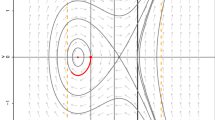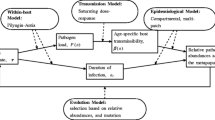Abstract
For a modified Anderson and May model of host parasite dynamics it is shown that infections of different levels of virulence die out asymptotically except those that optimize the basic reproductive rate of the causative parasite. The result holds under the assumption that infection with one strain of parasite precludes additional infections with other strains. Technically, the model includes an environmental carrying capacity for the host. A threshold condition is derived which decides whether or not the parasites persist in the host population.
Similar content being viewed by others
References
Anderson, R. M.: Transmission dynamics and control of infectious disease agents. In: Anderson, R. M.; May, R. M. (eds.) Population biology of infectious diseases. Dahlem Workshop Reports: Life Sciences Research Report 25. Berlin Heidelberg New York: Springer 1982
Anderson, R. M.; May, R. M.: Population biology of infectious diseases. Part I. Nature 280, 361–367 (1979)
Anderson, R. M.; May, R. M.: The population dynamics of microparasites and their invertebrate hosts. Philos. Trans. R. Soc. Lond., B 291, 451–524 (1981)
Anderson, R. M.; May, R. M.: Co-evolution of host and parasites. Parasitology 85, 411–426 (1982a)
Anderson, R. M.; May, R. M. (eds.): Population biology of infectious diseases. Dahlem workshop reports: life sciences research report 25. Berlin Heidelberg New York: Springer 1982b
Beck, K.: Co-evolution. Mathematical aspects of host-parasite interactions. J. Math. Biol. 19, 63–77 (1984)
Beverton, R. J. H.; Holt, S. J.: On the dynamics of exploited fish populations. Fishery Investigations, Series 2, 19. London: H.M.S.O. 1957
Bremermann, H. J.: Reliability of proliferation controls. The Hayflick limit and its breakdown in cancer. J. theor. Biol. 97, 641–662 (1982)
Bremermann, H. J.: Theory of catastrophic diseases of cultivated plants. J. theor. Biol. 100, 255–274 (1983)
Bremermann, H. J.: The adaptive significance of sexuality. In: Stearns, S. C. (ed.) The evolution of sex and its consequences. Basel Boston: Birkhäuser 1987
Bremermann, H. J.; Fiedler, B.: On the stability of polymorphic host-pathogen populations. J. theor. Biol. 117, 621–631 (1985)
Bremermann, H. J.; Pickering, J.: A game-theoretical model of parasite virulence. J. theor. Biol. 100, 411–426 (1983)
Boyce, W. E.; DiPrima, R. C.: Elementary differential equations and boundary value problems, 3rd edn. New York: Wiley 1977
Burdon, J. J.: Diseases and plant population biology. Cambridge: Cambridge University Press 1987
Butler, G. J.; Hsu, S. B.; Waltman, P.: Coexistence of competing predators in a chemostat. J. Math. Biol. 17, 133–151 (1983)
Butler, G. J.; Waltman, P.: Persistence in dynamical systems. J. Differ. Equations 63, 255–263 (1986)
Castillo-Chavez, C.; Hethcote, H. W.; Andreasen, V.; Levin, S. A.; Wei-min Liu: Cross-immunity in the dynamics of homogeneous and heterogeneous populations. In: Proc. of the Research Conference, Second Autumn Course in Mathematical Ecology, Trieste, 1986. Singapore: World Scientific Publishing Co. (in press) 1988
Castillo-Chavez, C.; Hethcote, H. W.; Andreasen, V.; Levin, S. A.; Wei-min Liu: Epidemiological models with age structure and proportionate mixing. J. Math. Biol., vol. 27, no. 3 (1989)
Dietz, K.: Transmission and control of arbovirus diseases. In: Ludwig, D.; Cooke, K. L. (eds.). Proceedings of a SIMS Conference on Epidemiology. Philadelphia: SIAM 1975
Dietz, K.: Epidemiologic interference of virus populations. J. Math. Biol. 8, 291–300 (1979)
Dietz, K.: Overall population patterns in the transmission cycle of infectious disease agents. In: Anderson, R. M.; May, R. M. (eds.) Population biology of infectious diseases. Dahlem Workshop Reports: Life Sciences Research Report 25. Berlin Heidelberg New York: Springer 1982
Fenner, F.; Ratcliffe, F. N.: Myxomatosis. Cambridge: Cambridge University Press 1965
Fenner, F.; Myers, K.: Myxoma virus and myxomatosis in retrospect: the first quarter century of a new disease. In: Viruses and environment, pp. 539–570. London: Academic Press 1978
Gillespie, J. H.: Natural selection for resistance to epidemics. Ecology 56, 493–495 (1975)
Hartman, P.: Ordinary differential equations. New York: Wiley 1973
Hill, R. E.; Hastie, N. D.: Accelerated evolution in the reactive centre regions of serine protease inhibitors. Nature 326, 96–99 (1987)
Levin, B. R.; Allison, A. C.; Bremermann, H. J.; Cavalli-Sforza, L. L.; Clarke, B. C.; Frentzel-Beyme, R.; Hamilton, W. D.; Levin, S. A., May, R. M.; Thieme, H. R.: Evolution of parasites and hosts. Group report. In: Anderson, R. M.; May, R. M. (eds.) Population biology of infectious diseases. Dahlem Workshop Reports: Life Sciences Research Report 25. Berlin Heidelberg New York: Springer 1982
Levin, S. A.: Community equilibria and stability, and an extension of the competitive exclusion principle. Am. Naturalist 104, 413–423 (1970)
Levin, S. A.: Co-evolution. In: Freedman, H. I.; Strobeck, C. (eds.). Population biology (Lect. Notes Biomath., vol. 52) Berlin Heidelberg New York: Springer 1983a
Levin, S. A.: Some approaches to the modeling of co-evolutionary interactions. In: Nitecki, M. (ed.). Co-evolution. Chicago: University of Chicago Press 1983b
Levin, S. A.; Pimentel, D.: Selection of intermediate rates increase in parasite-host systems. Am. Naturalist 117, 308–315 (1981)
Lively, C. M.: Evidence from a New Zealand snail for the maintenance of sex by parasitism. Nature 328, 519–521 (1987)
May, R. M.: Stability and complexity in model ecosystems. Princeton, N.J.: Princeton University Press 1975
May, R. M.; Anderson, R. M.: Epidemiology and genetics in the co-evolution of parasites and hosts. Philos. Trans. R. Soc. Lond., B, 219, 281–313 (1983)
Maynard Smith, J.: Models in ecology. Cambridge: Cambridge University Press 1974
Palmieri, J. R.: Be fair to parasites. Nature 298, 220 (1982)
Ricker, W. E.: Stock and recruitment. J. Fish. Res. Bd. Canada 11, 559–623 (1954)
Saunders, I. W.: Epidemics in competition. J. Math. Biol. 11, 311–318 (1981)
Stearns, S. C. (ed.): The evolution of sex and its consequences. Basel Boston: Birkhäuser 1987
Author information
Authors and Affiliations
Additional information
Supported by a Heisenberg scholarship of Deutsche Forschungsgemeinschaft
Rights and permissions
About this article
Cite this article
Bremermann, H.J., Thieme, H.R. A competitive exclusion principle for pathogen virulence. J. Math. Biology 27, 179–190 (1989). https://doi.org/10.1007/BF00276102
Received:
Revised:
Issue Date:
DOI: https://doi.org/10.1007/BF00276102




